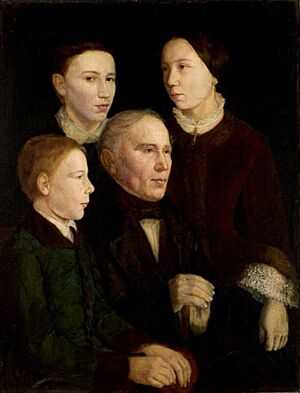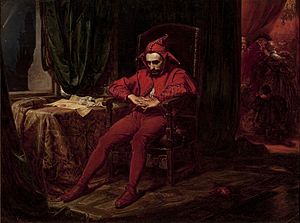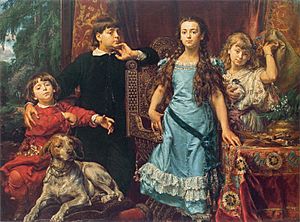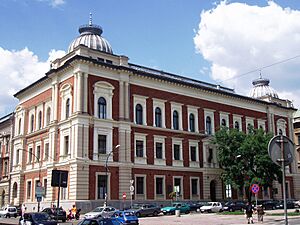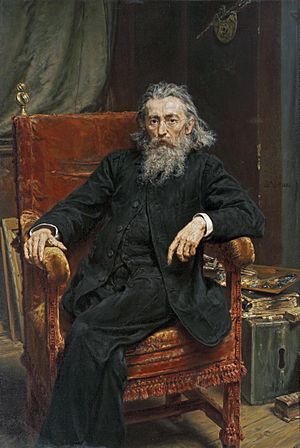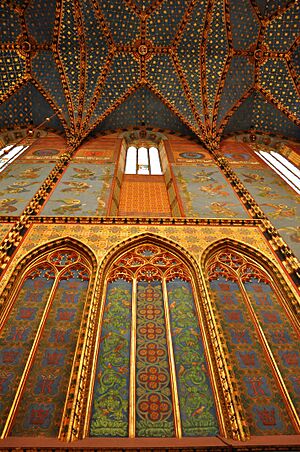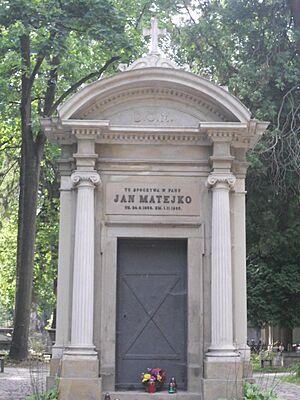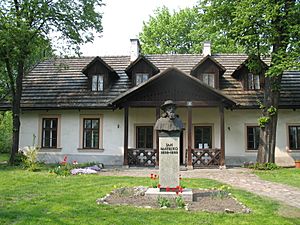Jan Matejko facts for kids
Quick facts for kids
Jan Matejko
|
|
|---|---|
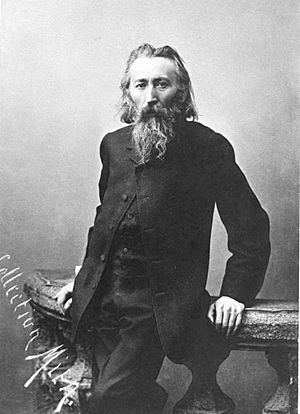
Jan Matejko, before 1883
|
|
| Born |
Jan Alojzy Matejko
24 June 1838 Free City of Kraków
|
| Died | 1 November 1893 (aged 55) Kraków, Grand Duchy of Kraków, Austrian Poland
|
| Resting place | Rakowicki Cemetery, Kraków, Poland |
| Nationality | Polish |
| Education |
|
| Known for | Painting, drawing, teaching |
|
Notable work
|
|
| Movement | History painting, academic art |
| Spouse(s) | Teodora Giebułtowska |
| Awards |
|
Jan Alojzy Matejko (born June 24, 1838 – died November 1, 1893) was a famous Polish painter. He was known for his amazing history paintings, which showed important moments from Polish history. Many people think he was the greatest Polish painter ever, even calling him the "national painter" of Poland.
Matejko created huge oil paintings like Rejtan (1866), the Union of Lublin (1869), the Astronomer Copernicus, or Conversations with God (1873), and the Battle of Grunwald (1878). He also painted many portraits and even created a book of Polish monarchs. He designed murals for St. Mary's Basilica, Kraków.
He spent most of his life in Kraków. He studied at the Kraków Academy of Fine Arts and later became its director. Today, the school is called the Jan Matejko Academy of Fine Arts in his honor. Many of his students became famous artists themselves, like Jacek Malczewski and Stanisław Wyspiański. He is often called "the Father of Young Poland" art.
Contents
Who Was Jan Matejko?
Early Life and Artistic Start
Jan Matejko was born in Free City of Kraków on June 24, 1838. His father, Franciszek Matejko, was a Czech music teacher. His mother, Joanna Karolina Rossberg, was half-German and half-Polish. Jan was one of eleven children. His mother passed away when he was very young. His aunt, Anna Zamojska, helped raise him and his siblings.
As a child, Jan saw big historical events in Kraków. He witnessed the Kraków Uprising in 1846 and the siege of Kraków in 1848. These events ended the Free City of Kraków. Two of his older brothers fought in these conflicts. One died, and the other had to leave the country.
Jan had trouble with school subjects, but he showed amazing artistic talent early on. At age fourteen, he joined the School of Fine Arts in Kraków. He studied there from 1852 to 1858. His teachers included Wojciech Korneli Stattler and Władysław Łuszczkiewicz. Jan chose to focus on historical painting. His first major work was The Shuyski Tsars before Zygmunt III in 1853.
After graduating in 1859, Matejko received a scholarship to study in Munich and Vienna. But he soon returned to Kraków. He set up his studio in his family home on Floriańska Street. It took him a few years to become successful.
In 1860, Matejko published an album called Clothing in Poland. This project showed his deep interest in Polish history. He wanted to share this history and inspire patriotism among Poles. His financial situation got better when he sold two paintings: The assassination of Wapowski (1861) and Jan Kochanowski over the body of his daughter Urszulka (1862).
In 1862, he finished Stańczyk. This painting became one of his most famous works. It showed a big change in Matejko's art. He started to not just illustrate history, but also to comment on its deeper meaning.
During the January Uprising of 1863, Matejko couldn't fight because of his poor health. But he helped by giving most of his savings to the cause. He even helped transport weapons to the rebels. His painting Skarga's Sermon (1864) brought him a lot of attention. In November 1864, he became a member of the Kraków Scientific Society. This was because of his important historical paintings. On November 21, he married Teodora Giebułtowska. They had five children together.
Becoming a Famous Artist
After 1865, Matejko became famous around the world. His Skarga's Sermon won a gold medal at the 1865 Paris Salon. In 1867, his painting Rejtan also won a gold medal at the World Exhibition in Paris. Emperor Franz Joseph I of Austria bought it for a lot of money.
His next big painting was the Union of Lublin (1867-1869). It was praised in Paris and won Matejko the Cross of the Légion d'honneur. Then came Stefan Batory at Pskov (1871). In 1872, he finished The Astronomer Copernicus, or Conversations with God. This painting was bought by the Jagiellonian University.
From the 1870s, Matejko had a secretary, Marian Gorzkowski. He became Matejko's close friend and helped him a lot. In 1872, Matejko was offered to lead the Prague Academy of Fine Arts. He also received a similar offer from the Kraków School of Fine Arts. He chose the Kraków position and became its principal.
In 1874, he completed Zawieszenie dzwonu Zygmunta (The Hanging of the Sigismund bell). In 1878, he created another masterpiece, The Battle of Grunwald. That year, he received a special "honorary grand gold" medal in Paris. The Kraków city council gave him a ceremonial scepter. This symbolized his "royal status in fine art."
From 1880 to 1882, he worked on The Prussian Tribute. Matejko gave this painting to "the Polish nation." Because of this, he became an honorary citizen of Kraków. One of the city's squares was even renamed Matejko Square.
In 1883, he finished Jan Sobieski at Vienna. This painting was given to Pope Leo XIII as a gift from Poland. Matejko was part of the group that delivered it to Rome. He received a special award, the Knight Commander with Star of the Order of Pius IX. The painting is now in the Vatican Museums. Matejko also spoke out on political issues and worked to protect historical buildings in Kraków.
In 1887, Matejko received an honorary doctorate from the Jagiellonian University. In 1888, he completed The Battle of Racławice. Between 1890 and 1892, he published a series of drawings of all the monarchs of Poland. These drawings became the standard way people imagined these historical figures. In 1891, he painted Constitution of the 3 May. He started another large work, The Oaths of Jan Kazimierz, but he passed away before finishing it. In 1892, a year before his death, he painted his Self-portrait.
Portraits and Other Artworks
Besides his history paintings, Matejko was also a great portrait painter. He painted university rectors and many family members and friends. He created 320 oil paintings and thousands of drawings and watercolors. He also designed the large polychrome murals for the St. Mary's Basilica, Kraków (1889–1891). This church is now a UNESCO World Heritage Site.
His Final Years
Matejko suffered from a stomach illness. He died in Kraków on November 1, 1893, from internal bleeding. His funeral on November 5 was attended by many people. News of his death was reported in many European newspapers. He was buried in Kraków's Rakowicki Cemetery.
Matejko's Importance and Style
Jan Matejko is considered one of the most important Polish painters. Many see him as "Poland's greatest history painter." He was a very popular figure for the nation. His style was influenced by Wilhelm von Kaulbach, who believed in "historical symbolism." This meant that the artist could interpret past events and blend historical facts with their own ideas. Matejko's painting technique is praised for its "brightness, detail, and imagination."
He played a huge role in sharing Polish history. His works helped keep the memory of Poland's past alive, especially when the country was divided by other European powers. His paintings, which were copied thousands of times, became the standard way to illustrate key moments in Polish history. His 1860 album, Ubiory w Polsce (Costume in Poland), is still a valuable historical resource.
Awards and Recognition
Matejko received many awards and honors throughout his life:
- Chevalier de la Legion d'honneur (Knight of the Legion of Honor), 1870, for his Union of Lublin painting.
- Gold Medal at the Paris Salon in 1867 for Rejtan.
- Member of the Academy of Fine Arts (1873).
- Gold Medal at the World Exhibition in 1878.
- Commander's Cross of the Order of Franz Joseph.
- Commander's Cross of the Order of the Iron Crown.
- Commander's Cross with Star of the Order of Pius IX.
- Gold Medal of the Munich Academy of Art.
- Papal Gold Medal from Pope Leo XIII.
- Honorary citizenship of several cities, including Kraków and Lwów.
- Doctor honoris causa from the Jagiellonian University (1887).
- Member of the Institut de France (1874) and the Berlin Academy of Arts (1874).
Matejko's Legacy
Matejko wanted to show important events in Polish history using detailed historical facts. His early paintings were just historical scenes. But his later works, starting with Stańczyk (1862), aimed to inspire people with a patriotic message. Stańczyk shows a court jester, who represents Poland's conscience. He sits alone, thinking about war, while a happy crowd ignores him.
His paintings are displayed in many Polish museums. These include the National Museum in Warsaw, National Museum in Kraków, and National Museum in Wrocław. The National Museum in Kraków has a building just for Matejko, called The Jan Matejko House. It used to be his studio and family home. Another museum dedicated to him is the Jan Matejko Manor House in Krzesławice.
Teacher and Influencer
More than 80 painters were Matejko's students. Many were influenced by him when he was director of the Kraków School of Fine Arts. They are often called members of the "Matejko School." Some of them became part of the "Young Poland" art movement. Matejko is even called "Father of Young Poland."
Some of his famous students include:
- Maurycy Gottlieb
- Jacek Malczewski
- Józef Mehoffer
- Stanisław Wyspiański
Images for kids
-
Wladyslaw I Lokietek from the Gallery of Polish Monarchs
-
pen and ink drawing possibly of Bona Sforza, 1861
-
Blind Veit Stoss with granddaughter (1865), National Museum in Warsaw
Selected Works
Here is a list of some of Matejko's important paintings:
| # | Title | Year | Technique and size | Location | Illustration |
| 1. | Carowie Szujscy przed Zygmuntem III (The Shuysky Princes before King Sigismund III) | 1853 | oil on canvas 75.5 cm × 109 cm |
National Museum in Wrocław |  |
| 2. | Stańczyk | 1862 | oil on canvas 120 × 88 cm |
National Museum, Warsaw | 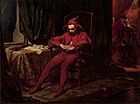 |
| 3. | Kazanie Skargi (Skarga's Sermon) | 1864 | oil on canvas 224 × 397 cm |
Royal Castle, Warsaw |  |
| 4. | Rejtan | 1866 | oil on canvas 282 × 487 cm |
Royal Castle, Warsaw |  |
| 5. | Alchemik Sędziwój (Alchemist Sendivogius) | 1867 | oil on canvas 73 × 130 cm |
Museum of Arts in Łódź |  |
| 6. | Unia Lubelska (Union of Lublin) | 1869 | oil on canvas 298 cm × 512 cm |
Lublin Museum |  |
| 7. | Stefan Batory pod Pskowem (Stefan Batory at Pskov) | 1872 | oil on canvas 322 × 545 cm |
Royal Castle, Warsaw |  |
| 8. | Astronom Kopernik, czyli rozmowa z Bogiem (Astronomer Copernicus, or Conversations with God) | 1873 | oil on canvas 225 × 315 cm |
Collegium Novum | 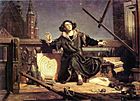 |
| 9. | Zawieszenie dzwonu Zygmunta (The Hanging of the Sigismund bell) | 1874 | oil on wood 94 × 189 cm |
National Museum, Warsaw |  |
| 10. | Śmierć króla Przemysła II (Death of King Przemysł II) | 1875 | Modern Gallery in Zagreb | 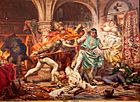 |
|
| 11. | Bitwa pod Grunwaldem (Battle of Grunwald) | 1878 | oil on canvas 426 × 987 cm |
National Museum, Warsaw |  |
| 12. | Polonia - Rok 1863 (Polonia - year 1863) | 1879 | oil on canvas 156 × 232 cm |
Czartoryski Museum, Kraków |  |
| 13. | Hołd pruski (The Prussian Homage) | 1880-82 | oil on canvas 388 × 875 cm |
National Museum, Kraków |  |
| 14. | Jan III Sobieski pod Wiedniem (John III Sobieski at Vienna) | 1883 | Vatican Museums |  |
|
| 15. | Wernyhora | 1883-84 | oil on canvas 290 × 204 cm |
National Museum, Kraków |  |
| 16. | Założenie Akademii Lubrańskiego w Poznaniu (Founding of the Lubrański Academy in Poznań) | 1886 | National Museum, Poznań | 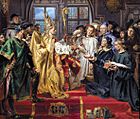 |
|
| 17. | Dziewica Orleańska (Maid of Orléans) | 1886 | oil on canvas 484 x 973 cm |
National Museum, Poznań |  |
| 18. | Bitwa pod Racławicami (Battle of Racławice) | 1888 | oil on canvas 450 × 890 cm |
National Museum, Kraków |  |
| 19. | cycle Dzieje cywilizacji w Polsce (History of civilisation in Poland) | 1888-1889 | |||
| 20. | Chrzest Litwy (Baptism of Lithuania) | 1888 | oil on canvas 60 × 115.5 cm |
National Museum, Warsaw |  |
| 21. | Zaprowadzenie chrześcijaństwa (Introduction of Christianity [to Poland]) | 1889 | oil on wood 79 × 120 cm |
National Museum, Warsaw | 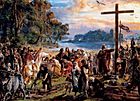 |
| 22. | cycle Poczet królów i książąt polskich (Fellowship of the kings and princes of Poland) | 1890-1892 | |||
| 23. | Konstytucja 3 Maja 1791 r. (Constitution of 3 May 1791) | 1891 | oil on canvas 247 cm × 446 cm |
Royal Castle, Warsaw |  |
| 24. | Carowie Szujscy przed Zygmuntem III (The Shuysky Princes before King Sigismund III) | 1892 | oil on wood 42 cm × 63 cm |
Jan Matejko House in Kraków |  |
| 25. | Self-portrait (Autoportret) | 1892 | oil on canvas 160 cm × 110 cm |
National Museum, Warsaw |  |
| 26. | Śluby Jana Kazimierza (Oath of Jan Kazimierz) | 1893 | oil on wood 315 cm × 500 cm |
National Museum, Wrocław |  |
See also
 In Spanish: Jan Matejko para niños
In Spanish: Jan Matejko para niños
- Culture of Kraków
- List of Polish painters


